| Top Ten NYC Architecture | top ten Monuments | |||||||||||||||
| For a more complete list, see Monument | ||||||||||||||||
| 1 | STATUE OF LIBERTY | |||||||||||||||
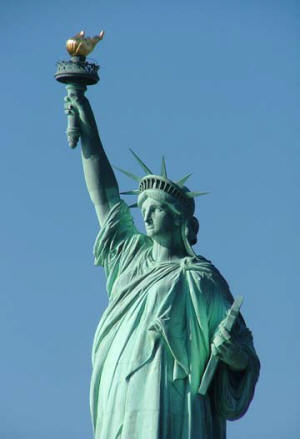 |
The statue is of a female figure walking upright, dressed in a robe and a seven point spiked rays representing a nimbus (halo), holding a stone tablet close to her body in her left hand and a flaming torch high in her right hand. The tablet bears the words "JULY IV MDCCLXXVI" (July 4, 1776), commemorating the date of the United States Declaration of Independence. The statue is made of a sheeting of pure copper, hung on a framework of steel (originally puddled iron) with the exception of the flame of the torch, which is coated in gold leaf. It stands atop a rectangular stonework pedestal with a foundation in the shape of an irregular eleven-pointed star. The statue is 151 feet 1 inch (46.5 m) tall, with the pedestal and foundation adding another 154 feet (46.9 m). Worldwide, the Statue of Liberty is one of the most recognizable icons of the United States,[2] and, more generally, represents liberty and escape from oppression. The Statue of Liberty was, from 1886 until the jet age, often one of the first glimpses of the United States for millions of immigrants after ocean voyages from Europe. Visually, the Statue of Liberty appears to draw inspiration from il Sancarlone or the Colossus of Rhodes. The statue is a central part of Statue of Liberty National Monument, administered by the National Park Service. |
|||||||||||||||
| 2 | Grant's Tomb | |||||||||||||||
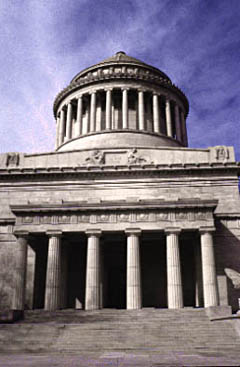 |
The mausoleum of Ulysses S. Grant, this building exemplifies the presence of social institutions and high culture in Morningside Heights. It also reflects the panthesitic experimentation of the period immediately following the Civil War. Financed by public contributions, the marble building is rendered in an eclectic classical style reminiscent of the Pantheon. Inside, it houses the black granite sarcophagi of Mr. and Mrs. Grant. Undulating mosaic benches by Pedro Silva and the City Arts Workshop [1973] surrounding the tomb were are a community project intended to beautify the site. |
|||||||||||||||
| 3 | Grand Army Plaza | |||||||||||||||
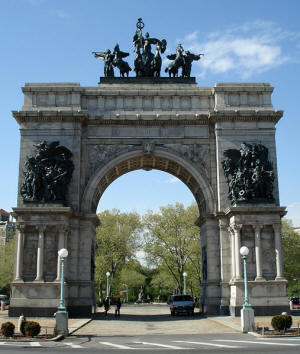 |
Olmsted & Vaux designed this monumental oval traffic circle in the spirit of Paris’ Etoile (now the Place Charles de Gaulle), that circular 12-spoked traffic rond point that bears in its central island the Arc de Triomphe, although they opposed an arch here. A masterstroke of city planning, this nexus joins their great Eastern Parkway, and their Prospect Park, with the avenues that preceded it on other geometries. This triumphal arch did not arrive for 22 years: the Soldiers’ and Sailors’ Memorial Arch W by John H. Duncan, architect of Grant’s Tomb, was built between 1889 and 1892, commemorating Union forces that perished in the Civil War. The arch provided, as in its Parisian inspiration, an excellent armature for sculpture, planned by Stanford White (McKim, Mead & White. 1894-1901), the most spectacular of which is Frederick MacMonnies’ huge quadriga on top (1898). Inside the arch itself is more subtle work, bas-reliefs of Lincoln (Thomas Eakins) and Grant (William O’Donovan), both installed in 1895. On the south pedestals are two bristling groups representing The Army and The Navy by MacMonnies (1901). A museum within the arch is open to the public. |
|||||||||||||||
| 4 | Washington Square Arch | |||||||||||||||
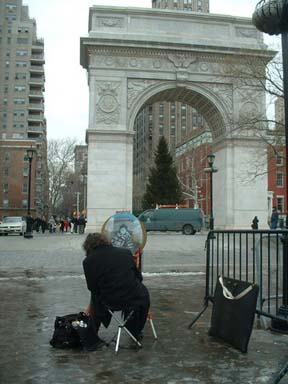 |
Inspired by Roman triumphal arches, this structure was erected in 1889 to celebrate the centennial of George Washington's inauguration. It replaced an arch on near the site which was a temporary structure made of wood and stucco. Having met with popular approval, Mckim Mead & White's original design was rebuilt in marble in 1891. Decorated with sculptures of Washington in both his civilian and military guises by Alexander Stirling Calder and Herman MacNeil, this arch became the symbol of a new America devoted to the arts. In the first decades of the 20th century, the West Village became an increasingly bohemian neighborhood, and the arch became a site of artistic and social rebellion. Cars no longer pass under the arch as they once did; the Arch remains one of the Village's important urban landmarks. |
|||||||||||||||
| 5 | Columbus Circle Fountain | |||||||||||||||
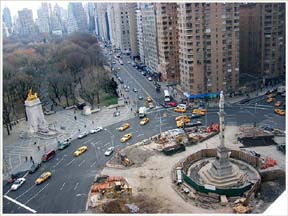 |
Situated in the center of Columbus Circle, at the southwest perimeter of Central Park is a magnificent towering marble statue of Christopher Columbus. The Italian mariner and navigator, is credited as the first European to sail across the Atlantic Ocean and with the discovery of the American continent. He stands atop the monument on a 70-foot granite column with bronze reliefs. The three ships depicted on the column represent the Nina, the Pinta, and the Santa Maria, the ships he sailed in 1492. At its base is a fountain with an angel holding a globe. Four hundred years later, to commemorate his voyage, this statue of Columbus was unveiled and presented by Italy to the United States. |
|||||||||||||||
| 6 | The Grand Army Plaza | |||||||||||||||
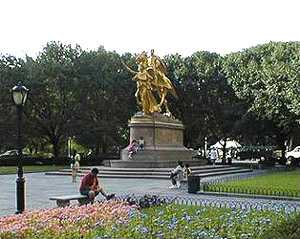 |
Aside from its status as the main east side gateway to the Park it has its own special significance to residents of the city and visitors alike. Like Plazas in other cities it defines New York as a center of culture and achievement. On the north side of the Plaza stands a brightly gilded bronze statue of the Union General William Tecumseh Sherman, the individual given much of the credit for ending the Civil War. His 1864 March to the Sea through the southern states dispersed the Confederacy and shattered their resistance. On the southern side opposite the Plaza Hotel stands the Pulitzer Memorial Fountain, a gift of the publisher of the old New York World. At the high peak of this tiered marble fountain stands the bronze statue of Pomona, the Roman goddess of abundance clearly a prophetic tribute to the growth and magnificence of the surrounding area upon which she gazes. Her back faced the former Vanderbilt Mansion that occupied the space now inhabited by Bergdorf Goodman, a fact not lost on historians who have read much into the placement. The bisected Plaza was influenced by the layout of the Place de la Concorde in Paris. |
|||||||||||||||
| 7 | Literary Walk | |||||||||||||||
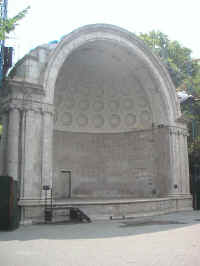 |
At the southern part of
the Mall, the main thoroughfare and gateway into Central Park is
Literary Walk. With mounting concern that the many requests to have
statues installed in the Park would eventually deprive it of its
naturalistic character, Olmsted proposed that the
Mall
itself be allocated to the installation of sculptures. It wasn't long after Olmsted's decree that the statues of William Shakespeare and Sir Walter Scott were installed in 1872. Soon afterward in 1880 Robert Burns was dedicated and following soon afterward for some unknown reason Columbus made it to this place of literary distinction in 1894. At the southern end of Literary walk is the only Park tribute to its creator Frederick Law Olmsted, the Olmsted Flower Bed. It features beautifully blooming pansies, impatiens and tulips and is a veritable explosion of color in the spring and well worth a visit for that alone. |
|||||||||||||||
| 8 | Richard Morris Hunt Memorial | |||||||||||||||
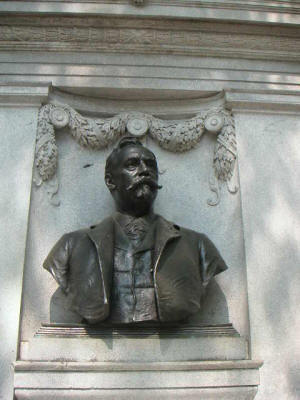 |
Located on the perimeter of the Central Park
and across from the Frick Museum, is
this monument to Richard
Morris Hunt an American architect of great prominence whose
defining signature emulated the French Beaux-Arts style. Several blocks
uptown, one can see a fine example of his artistic magnitude in the
facade of the Metropolitan Museum of Art. Hunt’s legacy is celebrated by renowned sculptor Daniel Chester French, whose most renowned work is the gigantic seated figure of Abraham Lincoln in the Lincoln Memorial in Washington, D.C. Here, the setting for the sculptures is an exedra - a semicircular portico with a curved bench - done in neo-Renaissance style. At its center is a bust of Hunt, with the two allegorical statues of Architecture first and then Painting and Sculpture standing guard at both ends of the semicircular colonnade. Inscribed on tablets around the exedra are the names of each of the organizations in which Hunt played a major role. |
|||||||||||||||
| 9 | 107th Infantry Memorial | |||||||||||||||
 |
Located along Fifth Avenue on the perimeter of Central Park, is the powerful statue of seven American soldiers who memorialize the grueling battles of World War I. Three of the men have bayonets ready for battle, while the weight of a wounded solider collapses into the embracing arms of a fellow comrade. As a former sergeant in the 107th, Karl Illava has brought the experience of his own emotions to portraying the valor of his comrades in battle. | |||||||||||||||
| 10 | 911 Memorial | |||||||||||||||